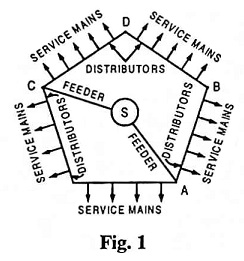DC Distribution Interview Questions and Answers:
1. What is distribution system ?
Ans. The part of power system which distributes electric power for local use is known as distribution system.
In general, the conductor system, by means of which electrical power is conveyed from bulk power source or sources (generating stations or major substations supplied over transmission lines) to the consumers is known as distribution system. It generally consists of feeders distributors and service mains, as shown in Fig. 1.
2. On what factors does the primary distribution voltage depend ?
Ans. The voltage employed for primary distribution system depends upon the amount of power to be supplied and distances of the substations required to be supplied.
3. What is/are the primary distribution voltage/voltages adopted in India ?
Ans. The usual value of primary distribution voltage in India is 11 kV but in case of high load density area it may be higher (33 or 66 kV) even.
4. What is the declared consumer voltage as per IE rules ?
Ans. The declared consumer voltage, according to IER is 415/240 V (i.e., 415 V between phases and 240 V between phase and neutral) with a permissible voltage variation of ±6%.
5. Why is it necessary to keep voltage variation at the consumer’s terminals as low as possible ?
Ans. All the appliances and motors are designed to be operated at a particular or declared value of voltage. Large voltage variation means either a too high or a too low voltage. Low voltage will cause not only in burning of motors/ appliances/equipment and insufficient lighting but also loss of revenue to the supplier. On the other hand high voltage will cause the lamps to burn out permanently and also may cause failure of other appliances. So the primary requirement of a distribution system is that voltage variations at the consumer’s terminals should be the lowest possible (not more than ±6% of the rated value).
6. What is a feeder ?
Ans. Feeder is a line which supplies a point of distribution network without being tapped at any intermediate point. In simple terms, the feeder may be defined as the line carrying current from the secondary substation to the distribution substations or as a primary distribution line.
7. What is a distributor ?
Ans. Distributor is a line from which tappings are taken along its length for providing supply to the consumers.
8. Why the voltage drop is of primary importance in the design of the distributors ?
Ans. The voltage drop is of primary importance in the design of distributors because of the statutory regulation providing the voltage variations permissible at the consumers terminals (±6% of declared or rated value). The size of the distributor should be such that the voltage at the consumers terminals remains within the permissible limits.
9. What is meant by primary and secondary distribution systems ?
Ans. Primary Distribution System: From generating stations the electrical power is usually transmitted to various substations through extra high tension transmission lines at voltage from 33 to 220 kV. At these substations this voltage is stepped down to 11 or 6.6 or 3.3 kV and power at this voltage is conveyed to different substations for distribution and to the bulk supply consumers. Such a system is known as high voltage or primary distribution system.
Secondary Distribution System: At distribution substations the voltage is stepped down to 415 volts. From these substations various low voltage (415 volts between phases and 240 volts between phase and neutral) distributors radiate out and feed the consumers. This system of distribution is known as low voltage or secondary distribution system.
10. What is meant by radial and ring main (mesh) systems of distribution ?
Ans. In radial distribution system, the feeder radiates from the secondary substation and branches into subfeeders and lateral which extends into all parts of the area served. Radial feeder is the simplest, most economical and most commonly used one. It has the drawbacks of poor reliability and greater voltage drop feeder. In the ring main (mesh) scheme, the distributor makes a closed loop or ring, as shown in Fig. 9.22 and fed at or more than one points. Such an arrangement has the advantages of greater reliability and better flexibility.
11. Why dc 2-wire system is never employed for transmission purpose ?
Ans. Because of poor efficiency.
12. Why is radial system of distribution is not generally used ?
Ans. Because of poorest service reliability.
13. What are the advantages of ring main distributor ?
Ans. Better flexibility, greater reliability, better voltage regulation and less power losses.
14. Why is neutral wire taken of half cross section of either outer in a 3-wire dc distribution system ?
Ans. Since only out of balance current flows through the middle or neutral wire, so generally neutral wire is taken of half cross section of either outer.
15. What is a booster ?
Ans. Booster is a low-voltage, high-current series wound dc generator inserted into a dc circuit to add or inject a certain voltage proportional to circuit current.
16. For what purpose a booster is employed ?
Ans. A booster (low-voltage, high-current series wound dc generator) is used for compensating voltage drop in the feeder.
